优先队列——二项队列(binominal queue)
【0】README
0.1) 本文文字描述部分转自 数据结构与算法分析, 旨在理解 优先队列——二项队列(binominal queue) 的基础知识;
0.2) 本文核心的剖析思路均为原创(insert,merge和deleteMin的操作步骤图片示例), 源代码均为原创;
0.3) for original source code, please visit https://github.com/pacosonTang/dataStructure-algorithmAnalysis/tree/master/chapter6/p152_binominal_queue
【1】二项队列相关
1.0)Attention: 二项队列中不允许有高度相同的二项树存在该队列中;
1.1)problem+solution:
- 1.1.1)problem:虽然左式堆和斜堆每次操作花费O(logN)时间, 这有效地支持了合并, 插入和deleteMin, 但还是有改进的余地,因为我们知道, 二叉堆以每次操作花费常数平均时间支持插入。
- 1.1.2)solution: 二项队列支持所有这三种操作(merge + insert + deleteMin), 每次操作的最坏情形运行时间为O(logN), 而插入操作平均花费常数时间; (干货——优先队列的三种基本操作——merge + insert + deleteMin)
1.2)相关定义
- 1.2.1) 二项队列定义: 二项队列不同于我们看到的所有优先队列的实现之处在于, 一个二项队列不是一颗堆序的树, 而是堆序树的集合,称为森林;(干货——二项队列的定义和构成,二项队列是二项树的集合,而二项树是一颗堆序树)
- 1.2.2)二项树定义: 堆序树中的每一颗都是有约束的形式。 (干货——二项树的定义)
- 1.2.3)二项树的构成:每一个高度上至多存在一颗二项树, 高度为0的二项树是一颗单节点树; 高度为k 的二项树Bk 通过将一颗二项树 Bk-1 附接到另一颗二项树Bk-1 的根上而构成;(干货——二项树的构成)
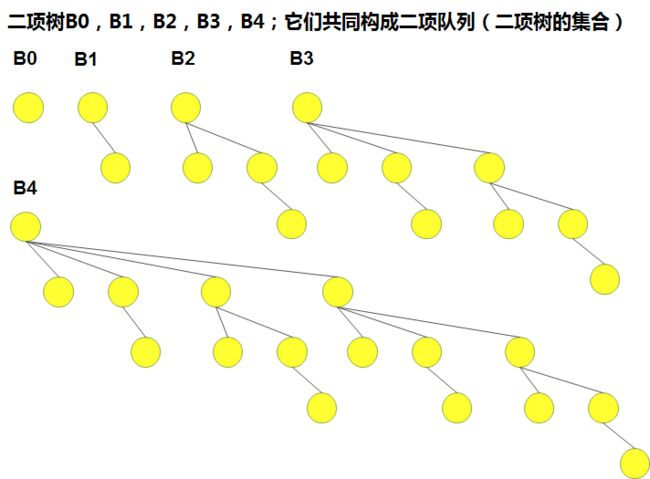
对上图的分析(Analysis):
A1)二项树的性质:
- A1.1)从图中看到, 二项树Bk 由一个带有儿子B0, B1, …, Bk-1的根组成;
- A1.2)高度为k 的二项树恰好有2^k 个节点;
- A1.3) 而在深度d 的节点数是 二项系数 。
A2)如果我们把堆序添加到二项树上, 并允许任意高度上最多有一颗二项树,那么我们能够用二项树的集合唯一地表示任意大小的优先队列;
【2】二项队列操作(merge + insert + deleteMin)
2.1)合并操作(merge) (干货——合并操作的第一步就是查看是否有高度相同的二项树,如果有的话将它们merge)
- step1) H1 没有高度为0的二项树而H2有,所以将H2中高度为0的二项树直接作为H3的一部分;(直接的意思==中间不需要merge);
- step2) H1 和 H2 中都有高度为1的二项树,将它们进行merge, 得到高度为2的二项树(根为12);
- step3)现在存在三颗高度为2的二项树(根分别为12, 14, 23),将其中两个进行merge(如merge根为12 和 根为14 的二项树),得到高度为3的二项树;
- step4)所以,最后,我们得到二项队列, 其集合包括:高度为0的二项树(根为13), 高度为1的二项树(根为23),高度为3的二项树(高度为12);
Attention)
- A1)显然,merge操作是按照高度升序依次进行的;
- A2)最后得到的二项队列不存在高度相同的二项树,即使存在,也要将高度相同的二项树进行merge;
- A3)二项队里中的二项树的高度不必囊括所有的升序实数,即不必一定是0, 1, 2, 3,4 等等; 也可以是0, 1, 3 等;
- A4)单节点树的高度为0; (干货——树高度从零起跳)
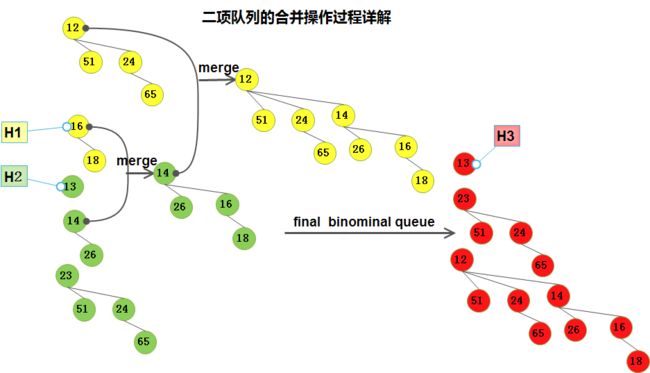
2.2)插入操作(insert) (干货——insert操作是merge操作的特例,而merge操作的第一步就是查看是否有高度相同的二项树,如果有的话将它们merge)
- 2.2.1)插入操作实际上: 就是特殊情形的合并, 我们只需要创建一颗单节点树并执行一次merge;
- 2.2.2)更准确地说: 如果元素将要插入的那个优先队列中不存在的最小的二项树是Bi, 那么运行时间与 i + 1 成正比;
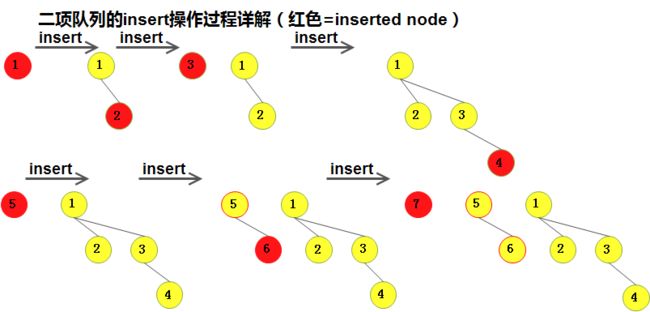
对上图的分析(Analysis):
- A1) 4 插入之后,与B0(根为3)进行merge, 得到一颗高度为1的树B1’(根为3);
- A2)将B1’ 与 B1(根为1) 进行merge 得到高度为2 的树B2’(根为1), 它是新的优先队列;
- A3)在插入7之后的下一次插入又是一个坏情形, 因为需要三次merge操作;
2.3)删除最小值操作(deleteMin)
- step1)找出一颗具有最小根的二项树来完成, 令该树为Bk, 令原始序列为H;
- step2)从H中除去Bk, 形成新的二项队列H’;
- step3)再除去Bk的根, 得到一些二项树B0, B1, …, Bk-1, 它们共同形成优先队列H”;
- step4) 合并H’ 和 H” , 操作结束;
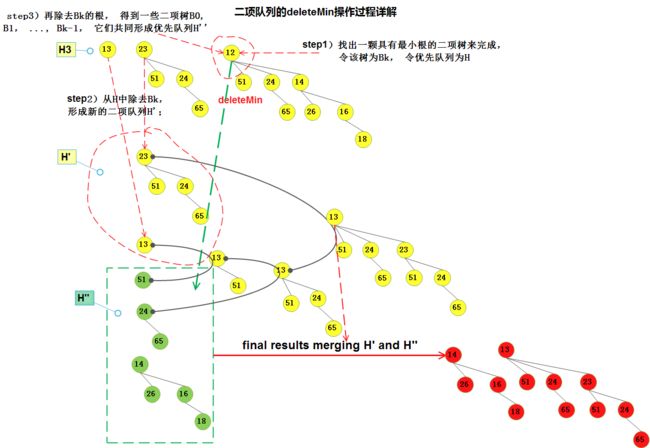
【3】 source code and printing results
3.1)source code at a glance
Attention)二项队列的实现源代码用到了 儿子兄弟表示法;
#include "binominal_queue.h"
#define MINIMAL 10000
int minimal(BinominalQueue bq)
{
int capacity;
int i;
int minimal;
int miniIndex;
minimal = MINIMAL;
capacity = bq->capacity;
for(i=0; iif(bq->trees[i] && bq->trees[i]->value < minimal)
{
minimal = bq->trees[i]->value;
miniIndex = i;
}
}
return miniIndex;
}
// initialize the BinominalQueue with given capacity.
BinominalQueue init(int capacity)
{
BinominalQueue queue;
BinominalTree* trees;
int i;
queue = (BinominalQueue)malloc(sizeof(struct BinominalQueue));
if(!queue)
{
Error("failed init, for out of space !");
return queue;
}
queue->capacity = capacity;
trees = (BinominalTree*)malloc(capacity * sizeof(BinominalTree));
if(!trees)
{
Error("failed init, for out of space !");
return NULL;
}
queue->trees = trees;
for(i=0; iqueue->trees[i] = NULL;
}
return queue;
}
// attention: the root must be the left child of the binominal tree.
int getHeight(BinominalTree root)
{
int height;
if(root == NULL)
{
return 0;
}
height = 1;
while(root->nextSibling)
{
height++;
root = root->nextSibling;
}
return height;
}
// merge BinominalQueue bq2 into bq1.
void outerMerge(BinominalQueue bq1, BinominalQueue bq2)
{
int height;
int i;
for(i=0; icapacity; i++)
{
height = -1;
if(bq2->trees[i])
{
height = getHeight(bq2->trees[i]->leftChild);
// attention for the line above
// height = height(bq2->trees[i]->leftChild); not height = height(bq2->trees[i]);
merge(bq2->trees[i], height, bq1);
}
}
}
// merge tree h1 and h2 = bq->trees[height],
// who represents the new tree and old one respectively.
BinominalTree merge(BinominalTree h1, int height, BinominalQueue bq)
{
if(h1 == NULL)
{
return h1;
}
if(bq->trees[height] == NULL) // if the queue don't has the B0 tree.
{
bq->trees[height] = h1;
return bq->trees[height];
}
else // otherwise, compare the new tree's height with that of old one.
{
if(h1->value > bq->trees[height]->value) // the new should be treated as the parent of the old.
{
innerMerge(bq->trees[height], height, h1, bq);
}
else // the old should be treated as the parent of the new.
{
innerMerge(h1, height, bq->trees[height], bq);
}
}
return h1;
}
BinominalTree lastChild(BinominalTree root)
{
while(root->nextSibling)
{
root = root->nextSibling;
}
return root;
}
// merge tree h1 and h2 = bq->trees[height],
// who represents the new tree and old one respectively.
BinominalTree innerMerge(BinominalTree h1, int height, BinominalTree h2, BinominalQueue bq)
{
if(h1->leftChild == NULL)
{
h1->leftChild = h2;
}
else
{
lastChild(h1->leftChild)->nextSibling = h2;
// attention for the line above
// lastChild(h1->leftChild)->nextSibling = h2 not lastChild(h1)->nextSibling = h2
}
height++;
bq->trees[height-1] = NULL;
merge(h1, height, bq);
return h1;
}
// insert an element with value into the priority queue.
void insert(ElementType value, BinominalQueue bq)
{
TreeNode node;
node = (TreeNode)malloc(sizeof(struct TreeNode));
if(!node)
{
Error("failed inserting, for out of space !");
return ;
}
node->leftChild= NULL;
node->nextSibling = NULL;
node->value = value;
merge(node, 0, bq);
}
// analog print node values in the binominal tree, which involves preorder traversal.
void printPreorderChildSibling(int depth, BinominalTree root)
{
int i;
if(root) {
for(i = 0; i < depth; i++)
printf(" ");
printf("%d\n", root->value);
printPreorderChildSibling(depth + 1, root->leftChild);
printPreorderChildSibling(depth, root->nextSibling);
}
else
{
for(i = 0; i < depth; i++)
printf(" ");
printf("NULL\n");
}
}
// print Binominal Queue bq
void printBinominalQueue(BinominalQueue bq)
{
int i;
for(i=0; icapacity; i++)
{
printf("bq[%d] = \n", i);
printPreorderChildSibling(1, bq->trees[i]);
}
}
void deleteMin(BinominalQueue bq)
{
int i;
BinominalTree minitree;
BinominalTree sibling;
i = minimal(bq);
minitree = bq->trees[i]->leftChild; //minitree->value=51
free(bq->trees[i]);
bq->trees[i] = NULL;
while(minitree)
{
sibling = minitree->nextSibling;
minitree->nextSibling = NULL;
merge(minitree, getHeight(minitree->leftChild), bq);
minitree = sibling;
}
}
3.2) printing results
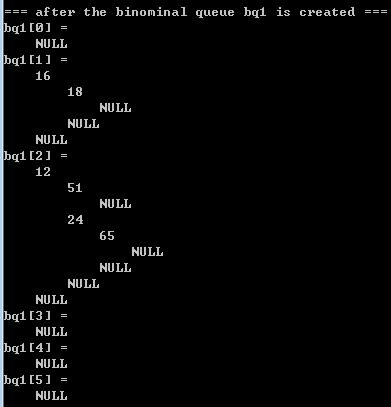 |
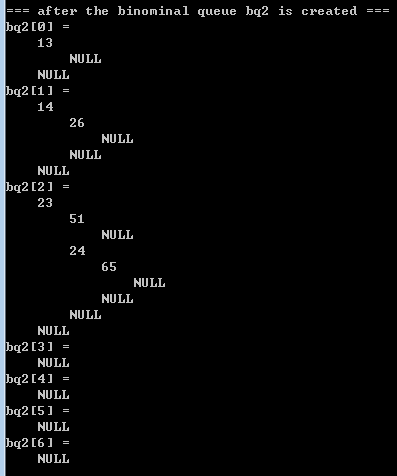 |
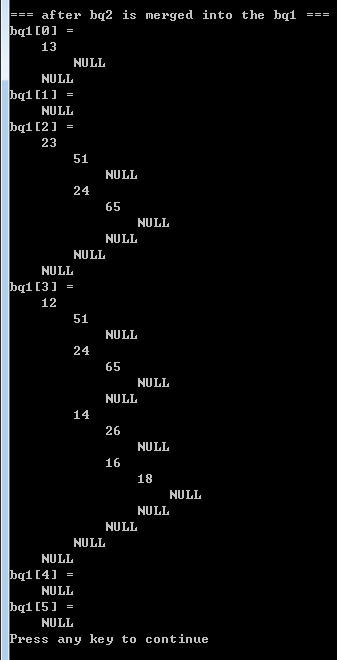 |
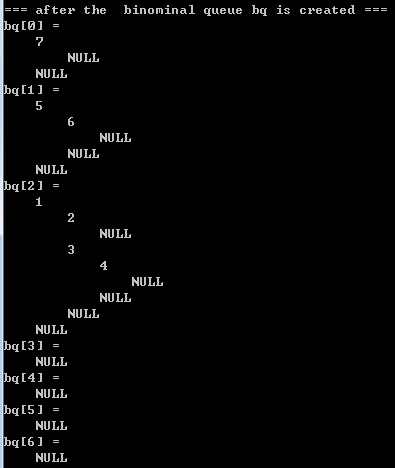 |
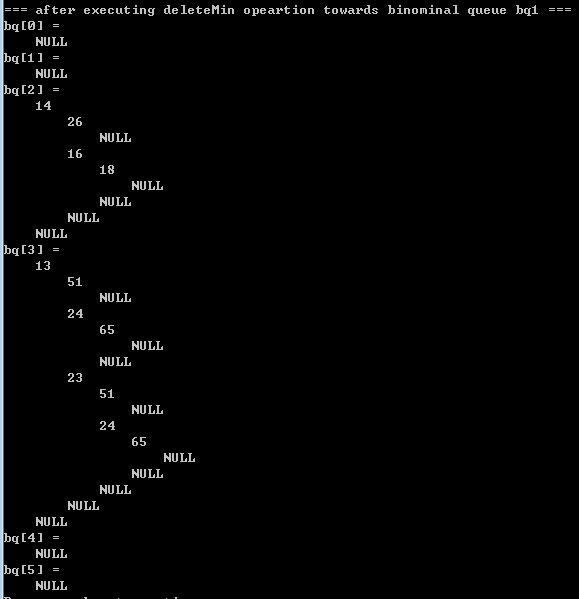 |